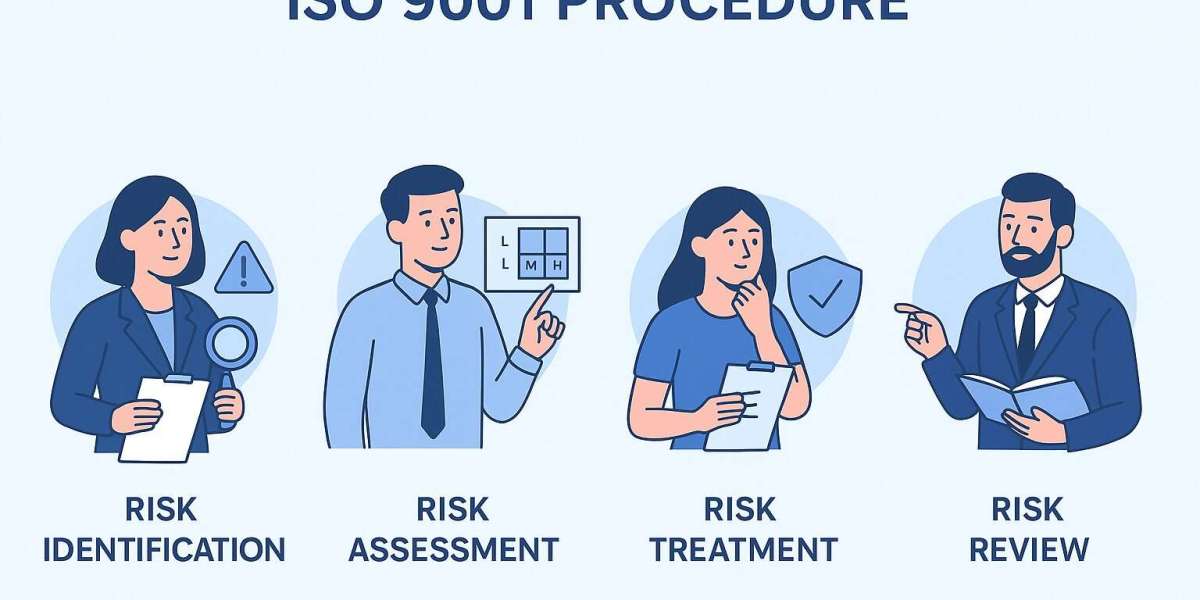Introduction
Organizations today operate in a world where uncertainty is constant, and risks can arise from multiple directions—market changes, supply chain disruptions, regulatory updates, or even customer demands. ISO 9001, the internationally recognized Quality Management System (QMS) standard, emphasizes the importance of risk-based thinking in its 2015 revision. Unlike earlier versions, which largely focused on preventive action, ISO 9001:2015 integrates risk-based thinking throughout all processes. Establishing a clear ISO 9001 procedure for risk-based thinking and risk management ensures that organizations not only comply with the standard but also enhance resilience, customer satisfaction, and continuous improvement.
Understanding Risk-Based Thinking in ISO 9001
Risk-based thinking is the proactive mindset that requires organizations to identify, evaluate, and manage risks and opportunities as part of routine business processes. Instead of treating risk as a standalone activity, ISO 9001 embeds it across planning, operations, performance evaluation, and continual improvement.
The approach recognizes that every process carries inherent risks and that structured management of these risks can prevent issues, reduce costs, and protect organizational reputation. This mindset is not limited to negative risks (threats); it also addresses opportunities—potential areas where the organization can gain advantages.
Objectives of an ISO 9001 Procedure for Risk Management
An effective procedure should:
- Provide a structured approach for identifying risks and opportunities.
- Ensure risks are analysed for potential impact on quality objectives.
- Define roles and responsibilities for risk assessment.
- Establish controls to minimize threats and maximize opportunities.
- Integrate risk thinking into everyday operations, decision-making, and audits.
By formalizing these objectives, organizations can achieve both compliance and long-term strategic advantage.
Key Elements of the Procedure
When drafting an ISO 9001 procedure for risk-based thinking and risk management, certain elements should be included to ensure consistency and clarity:
- Scope and Purpose
The procedure should clarify its intent—supporting compliance with ISO 9001 and ensuring risks are addressed across the QMS.
- Risk Identification
Define methods to capture risks across functions, such as:
- SWOT analysis (Strengths, Weaknesses, Opportunities, Threats)
- Brainstorming sessions with process owners
- Review of customer complaints and audit findings
- Industry benchmarking
- Supply chain evaluations
- Risk Assessment Criteria
Establish measurable criteria for evaluating risks. This typically includes:
- Likelihood (probability of occurrence)
- Impact (severity on quality, operations, or compliance)
- Detection (ability to identify the risk before it causes harm)
A risk matrix (low, medium, high) or numerical scoring method is often used to prioritize risks.
- Risk Treatment and Controls
For high-priority risks, outline the strategy:
- Avoid (eliminate the risk source)
- Mitigate (reduce probability or impact)
- Transfer (outsource or insure against risk)
- Accept (acknowledge and monitor, if minimal)
The procedure should also identify controls such as documented processes, staff training, or use of technology.
- Opportunities Management
Highlight how opportunities are considered alongside risks. For example, adopting a new technology may introduce risks but also offer efficiency gains. This ensures a balanced approach.
- Documentation and Records
Although ISO 9001 does not demand a formal "risk management procedure," organizations are expected to demonstrate evidence. Maintaining risk registers, risk assessment forms, and monitoring records provides this proof.
- Review and Continual Improvement
The procedure should integrate periodic reviews during management review meetings, internal audits, and process monitoring. This ensures risks remain relevant as the business evolves.
Benefits of Risk-Based Thinking under ISO 9001
A well-documented procedure for risk-based thinking delivers multiple advantages:
- Enhanced Customer Confidence: Customers trust organizations that manage uncertainty effectively.
- Proactive Problem-Solving: Instead of reacting to issues, risks are prevented.
- Improved Decision-Making: Data-driven risk assessments provide clarity for leadership.
- Compliance and Certification: Ensures alignment with ISO 9001 requirements.
- Operational Resilience: Helps organizations withstand disruptions like supply chain delays or sudden demand shifts.
Steps to Implement the Procedure
Organizations can follow these steps to implement risk-based thinking effectively:
- Train employees and management on risk-based thinking.
- Develop a risk register template and establish ownership.
- Integrate risk assessment into process design and change management.
- Monitor effectiveness of controls through audits and KPIs.
- Update risk procedures periodically to reflect market and organizational changes.
Conclusion
Risk-based thinking is at the heart of ISO 9001:2015 procedure, making it a critical element of quality management. By documenting and following a structured procedure for risk-based thinking and risk management, organizations can proactively safeguard operations, enhance customer trust, and seize opportunities for improvement. This approach not only ensures compliance but also builds a resilient, forward-looking organization capable of thriving in a competitive environment.
Through systematic identification, evaluation, and treatment of risks, companies strengthen their QMS, reduce uncertainty, and align processes with strategic objectives. In essence, risk-based thinking under ISO 9001 transforms risk into a tool for sustainable growth and continual improvement.



